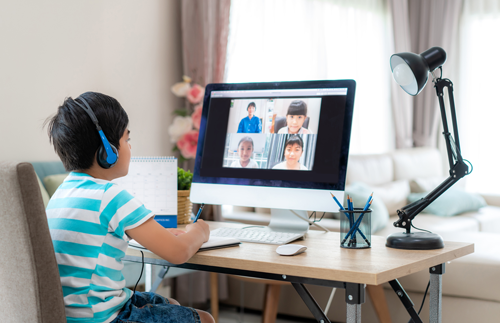The potential detrimental implications of the COVID-19 shutdowns have dominated headlines since social distancing precautions were first instated. Thus far, mental health-oriented research paints a more complex picture of the varying implications of the stay-at-home measures on children. The impact on mental health and well-being appears to be highly dependent upon place, resources, and various other factors.
A recent survey study by Emily Widnall and colleagues involving secondary students in South West England was conducted to evaluate “the impacts of COVID-19 and the resultant lockdown on adolescent mental health and wellbeing, social connections, and social media activity.” The results, described in a report released by the NIHR School for Public Health Research, reflect nuance in the implications of COVID-19 and highlight some of the positive implications for wellbeing experienced by many students following the implementation of disease containment precautions.
 Among Widnall and team’s most striking findings is that—within their sample of 1,047 youth surveyed pre-pandemic in October 2019 and post-lockdown initiation in April/May of 2020—an overall increase in perceptions of school connectedness occurred. Overall decreases in self-reported anxiety and increases in wellbeing were also observed.
Among Widnall and team’s most striking findings is that—within their sample of 1,047 youth surveyed pre-pandemic in October 2019 and post-lockdown initiation in April/May of 2020—an overall increase in perceptions of school connectedness occurred. Overall decreases in self-reported anxiety and increases in wellbeing were also observed.
These shifts, though not significant in magnitude, indicate small, positive changes in direction. Higher levels of relief about increased connectedness, wellbeing, and decreased anxiety were particularly pronounced among young people with mental health challenges reported pre-pandemic, yet were not observed among LGBTQ+ youth and those with health conditions.
For young people already struggling to connect in school, virtual learning opportunities may have advantages. These findings represent a stark contrast among one subset of students to the “tsunami of mental illness” prophesized in headlines.
“In March 2020, the UK was placed in lockdown in an effort to help slow the spread of Coronavirus (COVID-19). The lockdown has disrupted the lives and daily routines of everyone; however, the impact is likely to have had a particular impact on young people […].”
Many aspects of the COVID-19 have been unsettling and harmful to youth on an international scale, evidenced by outcomes ranging from increases in food insecurity in already vulnerable communities to unceremonious goodbyes and abrupt shifts in valued social traditions. Recent research has also raised the alarm about increases in youth loneliness associated with shutdowns. However, it may be unhelpful to make sweeping generalizations regarding the impact. There is a great deal of variability in effects based on the governmental response, community preparedness, community- and family-level resources, and social capital.
A recent study examining youth perspectives surrounding COVID-19 implications in Portugal captures the reality that effects are mixed. Some of the disadvantages to shutdowns reported among participants included reduced social opportunities, unstructured time, high academic expectations not sufficiently modified for the new online school format, and more. However, some reported advantages including increased time with loved ones at home, some scheduling flexibility, and time and space for leisurely activities that hadn’t previously been possible.
Other research has also indicated that although the COVID-19 pandemic has exposed and exacerbated disparities in access to care and resources in some respects, it has also meant adjustments to systems that weren’t altogether perfect pre-pandemic (e.g., schools).
Widnall and colleagues collected data at two time-points (one pre- and one post-initiation of England’s shutdown) separated by seven to eight months. Participants comprised a relatively racially/ethnically homogeneous (predominately White) sample of adolescents belonging to the same academic year cohort across 17 schools.
“A total of 1,047 Year 9 students (aged 13-14 years) in 17 schools completed this lockdown survey. Where we have made comparisons between time-points, we have used all matched data available for the outcomes of interest for students that completed both the pre-pandemic survey and the survey during lockdown (ranging from 721-770 participants).”
The team explored wellbeing overall, in addition to a variety of areas associated with wellbeing, including symptoms of anxiety, depression, social media use, social connectedness, school connectedness, peer connectedness, and family connectedness. The dimensions of connectedness examined were also analyzed in relation to other indications of mental health to disentangle pre- and post-pandemic trends. Additionally, researchers collected post-shutdown data regarding student worries associated with COVID-19.
Among the chief worries indicated by participants were fears about loved ones contracting COVID-19, fears about the wellbeing and mental health of friends and family, and fears about missing school. Almost all students surveyed perceived COVID-19 to be a serious issue. Over 50% of girls surveyed reported increases in social media use following the emergence of the pandemic, but boys did not.
The results indicate that, at least within this sample, some of the effects of virtual learning measures have been very positive, according to many students, specifically those with elevated pre-pandemic anxiety and reduced school connectedness. Notable exceptions included LGBTQ+ youth within the sample and those with disabilities and health conditions. Higher rates of anxiety and reduced well-being were indicated pre-pandemic and limited relief was experienced following shutdown measures. Many of the same challenges associated with wellbeing and connectedness persisted over time in these subgroups.
“In our large survey of Year 9 students during lockdown[, …] overall, we saw reductions in anxiety and rises in wellbeing. This may be due to the removal of stressors within the school environment, such as the pressure of academic work and challenging peer relationships, including bullying. As schools fully re-open, it is important to consider ways to prevent a rise in anxiety back to pre-pandemic levels. It will be particularly important to focus on support for students who already felt less connected to school, and those who had high anxiety prior to lockdown.”
Not only are the mental health “consequences” of COVID-19 less cut-and-dried than the media has portrayed, but, in some circumstances, COVID-19 precautions have led to new systems that may be working for students for whom business-as-usual wasn’t sufficient.
****
Widnall, E., Winstone, L., Mars, B., Haworth, C.M.A., & Kidger, J. (2020). Young People’s Mental Health during the COVID-19 Pandemic: Initial findings from a secondary school survey study in South West England. NIHR School for Public Health Research. (Link)















While schools are no doubt comparable to prisons in many ways, this is a lame excuse for removing children from all social contact (which poses almost zero risk to them) and sticking them in front of a screen for the better part of a day. This used to be seen as a problem, now it’s mandatory. It’s not good for your brain or your eyes. And despite the fact that it may be better than being beat up, bullied, and taunted, there are clearly many less drastic solutions, if that’s truly the concern.
Report comment
The improvements due to “virtual learning” were entirely accidental, and those who have made these observations are scurrying for cover, having no intention of discovering why such a large contingent of kids are less “mentally healthy” when exposed to the oppression of the school system.
Report comment
And for each one of these fortuitous instances there are probably DOZENS of parent-child relationships going through utter turmoil during key years of growth and development. It’s state-mandated child abuse, essentially.
Report comment
So you are saying that “virtual learning” on a large scale amounts to child abuse?
I’m a little surprised if that’s what you’re saying, since I’d expect you to see the school system as a primary means of keeping the unruly masses from rebelling. The whole enterprise is massively authoritarian from day one, and I believe a lot of what is not working in US society, at least, has to do with little kids being trained to invalidate their own perceptions and being forced to accommodate the “party line” on what is “right” and “wrong.” Not to mention the number of kids routed to the psychiatric system by schools.
Report comment
What’s wrong with US society is people believing the problems can be solved within the structure of US society. At any rate it’s the same propaganda regardless of the format.
But that’s not even what I’m talking about. Forcing children to watch computer screens for hours on end is child abuse in itself, no matter what the programming consists of. I’m interested in what the post-lockdown suicide rate will end up being among those under 18 (though not looking forward to the answer).
Report comment
Ah, I see. Similar child abuse to making kids sit in desks all day and do whatever the teachers tell them to do, I’d say.
Report comment
Except for the lack of humans with whom to establish comradery, or even rebel. And the mask/computer factor.
But wait — where are these home computers anyway if not on desks? And who gives the orders if not teachers (with an unpaid assist from parents)?
Report comment
Of course, I agree. I just don’t see that much difference, except that stressed parents have to be there with their kids and try to enforce the teachers’ dictates. Virtual learning will work better for some kids, worse for others, be the same for others, but it does not begin to address the flaws within the system, which is my point. Rather than simply observing that some kids are less anxious when they aren’t forced into an unnatural setting under the control of a person they may or may not respect with kids selected at random that they can’t get away from having to do things that may or may not make any sense, maybe they should be asking why going to such a setting induces so much anxiety in so many children, and maybe stop doing those things that make the environment so utterly oppressive? But that would presume that there is a desire to empower rather than oppress the students, which is probably a highly erroneous assumption.
Report comment
Meanwhile:
SAN JOAQUIN COUNTY, Calif. —
A student has died after a self-inflicted gunshot wound during a Zoom distance learning class Wednesday, officials said. The San Joaquin County Sheriff’s Office announced the student was an 11-year-old.
https://www.kcra.com/article/san-joaquin-county-student-shot-during-zoom-distance-learning/34851597
Report comment
Jeez! That’s horrible!
Report comment
I’m sure all the kids know they are in good hands as far as their “mental health” is concerned.
Dr Hogwash is waiting to do a zoom assessment.
Report comment
I just realized something else — “Virtual” is basically a synonym for “fake.” Substitute “fake” and it remains just as valid a sentence in most cases.
Or it could be taken to mean “almost,” which is another way of saying “no cigar,” i.e. fake.
Report comment